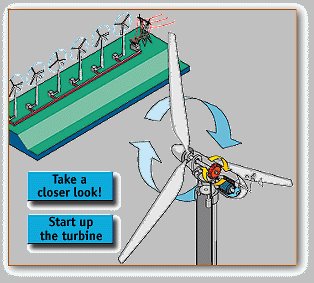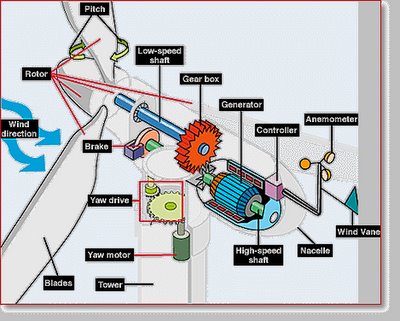How does a Wind Turbine Work?
 This aerial view of a wind power plant shows how a group of wind turbines can make electricity for the utility grid. The electricity is sent through transmission and distribution lines to homes, businesses, schools, and so on.
This aerial view of a wind power plant shows how a group of wind turbines can make electricity for the utility grid. The electricity is sent through transmission and distribution lines to homes, businesses, schools, and so on.These three-bladed wind turbines are operated "upwind," with the blades facing into the wind. The other common wind turbine type is the two-bladed, downwind turbine.
So how do wind turbines make electricity? Simply stated, a wind turbine works the opposite of a fan. Instead of using electricity to make wind, like a fan, wind turbines use wind to make electricity. The wind turns the blades, which spin a shaft, which connects to a generator and makes electricity. Utility-scale turbines range in size from 50 to 750 kilowatts. Single small turbines, below 50 kilowatts, are used for homes, telecommunications dishes, or water pumping.
Look at the Wind Turbine Close Up

Wind Turbine Glossary
Anemometer: Measures the wind speed and transmits wind speed data to the controller.
Blades: Most turbines have either two or three blades. Wind blowing over the blades causes the blades to "lift" and rotate.
Brake: A disc brake which can be applied mechanically, electrically, or hydraulically to stop the rotor in emergencies.
Controller: The controller starts up the machine at wind speeds of about 8 to 16 miles per hour (mph) and shuts off the machine at about 65 mph. Turbines cannot operate at wind speeds above about 65 mph because their generators could overheat.
Gear box: Gears connect the low-speed shaft to the high-speed shaft and increase the rotational speeds from about 30 to 60 rotations per minute (rpm) to about 1200 to 1500 rpm, the rotational speed required by most generators to produce electricity. The gear box is a costly (and heavy) part of the wind turbine and engineers are exploring "direct-drive" generators that operate at lower rotational speeds and don't need gear boxes.
Generator: Usually an off-the-shelf induction generator that produces 60-cycle AC electricity.
High-speed shaft: Drives the generator.
Low-speed shaft: The rotor turns the low-speed shaft at about 30 to 60 rotations per minute.
Nacelle: The rotor attaches to the nacelle, which sits atop the tower and includes the gear box, low- and high-speed shafts, generator, controller, and brake. A cover protects the components inside the nacelle. Some nacelles are large enough for a technician to stand inside while working.
Pitch: Blades are turned, or pitched, out of the wind to keep the rotor from turning in winds that are too high or too low to produce electricity.
Rotor: The blades and the hub together are called the rotor.
Tower: Towers are made from tubular steel (shown here) or steel lattice. Because wind speed increases with height, taller towers enable turbines to capture more energy and generate more electricity.
Wind direction: This is an "upwind" turbine, so-called because it operates facing into the wind. Other turbines are designed to run "downwind", facing away from the wind.
Wind vane: Measures wind direction and communicates with the yaw drive to orient the turbine properly with respect to the wind.
Yaw drive: Upwind turbines face into the wind; the yaw drive is used to keep the rotor facing into the wind as the wind direction changes. Downwind turbines don't require a yaw drive, the wind blows the rotor downwind.
Yaw motor: Powers the yaw drive.







0 Comments:
Post a Comment
<< Home